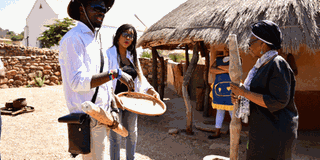adventure, Bakgatla-Ba-Kgafela,

Solomon Oleny, a journalist at Ngali, Uganda Airlines flight magazine, chats with tour guides at Mphebatho Cultural Museum in Pilanesberg Mountains about the process of making local brew. Photo by EDGAR R. BATTE.
What you need to know:
Experience. For the love of adventure, we toured Leeto Kgolo village in South Africa, writes EDGAR R. BATTE.
African heritage and culture is as diverse as is similar. A village tour of Leeto-Kgolo was a good insight of the parallels, for example the warm welcome that we received at the gates of Mphebatho Cultural Museum by a kindhearted tour guide.
Environment
The compound is dotted with mountain bikes that we would cycle through the village. But that is after exploring the museum, a stop-point for an informative sightseeing that gets us, journalists from different African countries, to appreciate the way of life; culture and history, of the Bakgatla-Ba-Kgafela people of the northwest province of South Africa that hail from South Africa and neighbouring Botswana.
You might want to know that just like you cherish the taste of pot water, so do they.
In the compound is a statue of Kgosi Linchwe the first who led the Bakgatla between 1899 and 1902.He built the structure that houses the museum. He is adorned in a hat, his forehead covered in a faint darkness. Much of his face is a portrait of a man in his evening years, with wrinkles and a thick moustache.
There is proof he was stylish by a coat and waistcoat. It is a half sketch of him held high on a strong marble fortress on which notes about his legacy are inscribed in black.
Museum wonders
On another face of the fort, is a list of soldiers who fought in war and were involved in the war at Ntwa Ya Kaefe. In the foreground, are two big pots on the veranda of the museum.
Up the staircase and into the museum, it is lit in different shades. Some strong and others subtle for visibility of the literature and pictures on the walls, explaining about the social structure and customs of the traditional healers and herbalists had a place among the Bakgatla-Ba-Kgafela.
There are photographs of different women that played remarkable roles in their culture, who created something from nothing. In another room, you will learn about the history of settlement of the natives.
The level and package of preservation of a rich history. The sight of pots and their role is similar to what you and I are accustomed to; some for cooking, brewing beer and storage of drinking water.
The difference only comes in their names. The small pots, locally known as mokgakwana serve as containers for keeping water cool, the slightly larger ones are used for fermenting traditional beer, bajalwa.
Brewing moment
We are later on hosted to a beer brewing session by one of the courtyard elders and two guides. We taste the potent made from cassava and millet, just the way it is done among some tribes in Uganda. Those in which porridge is stored are known as ting. Modern times have offered more options, away from the clay-made pots but the tradition is still preserved. I bet you have a plastic, metal and ceramic ‘pot’.
Traditional healers and herbalists had a place among the Bakgatla-Ba-Kgafela On other well-vanished wooden stools, are herbs that were, and certainly continue to be used to treat different ailments. The museum is located within a short distance of Pilanesberg mountains and National Park.




